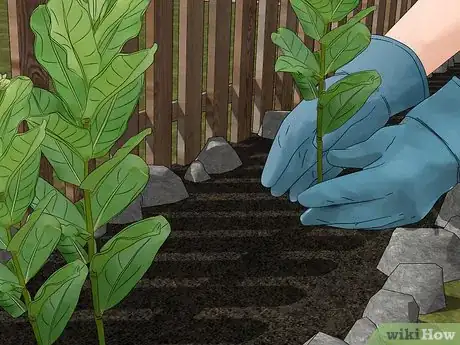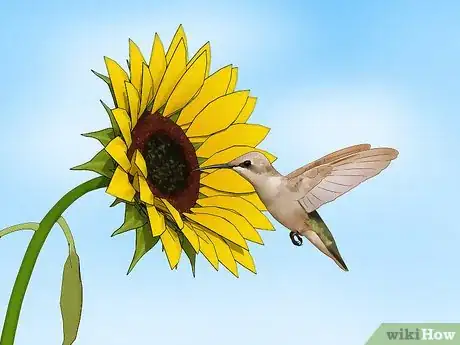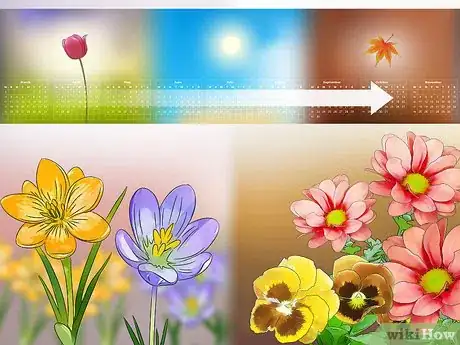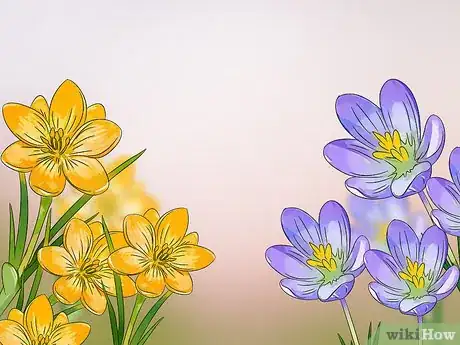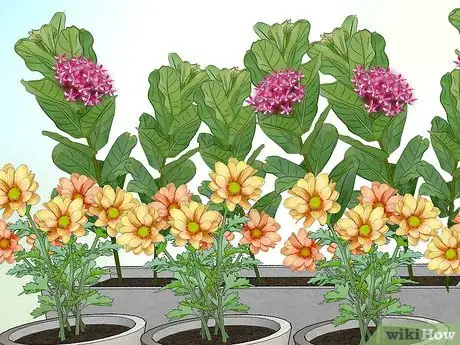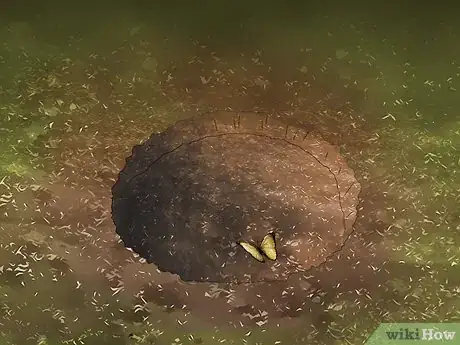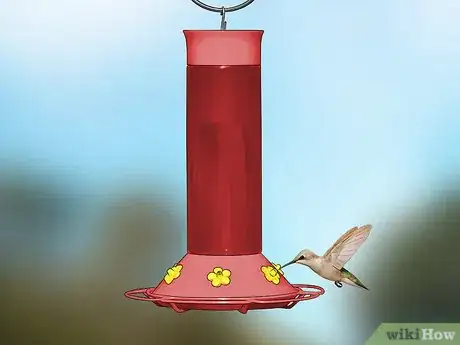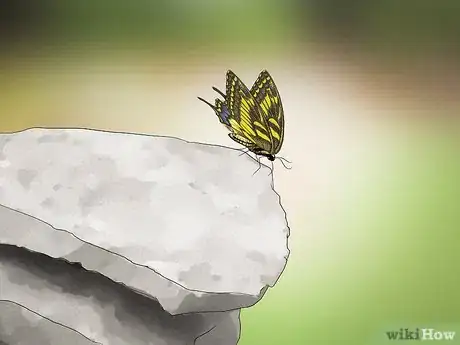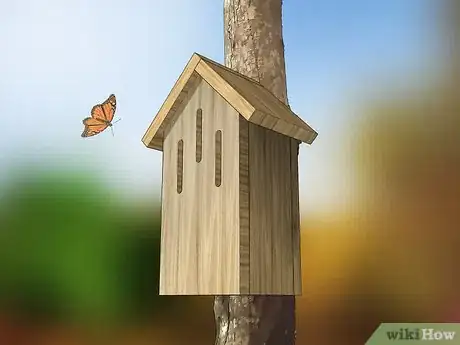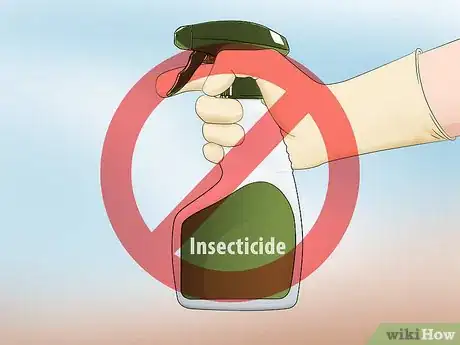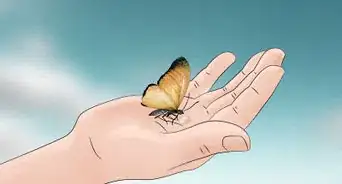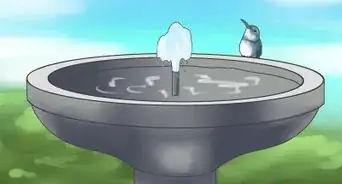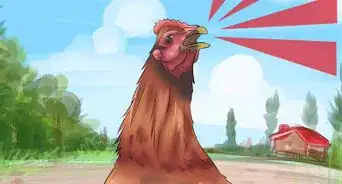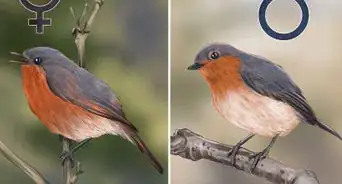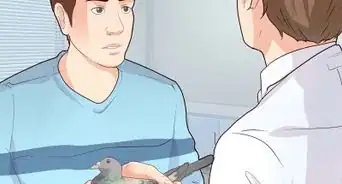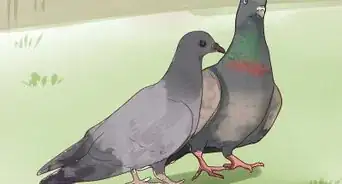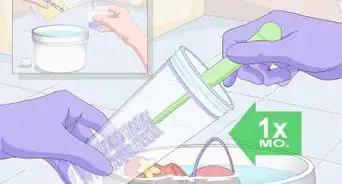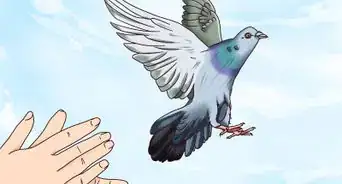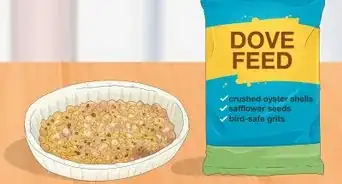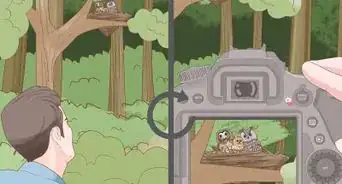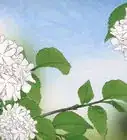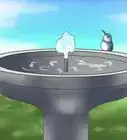This article was co-authored by Jeff Jones. Jeff Jones is a Bird Specialist based in Nashville, Tennessee. He is the writer of BirdOculars, a website dedicated to helping people become better birders. He has over 18 years of experience and specializes in feeding birds and wildlife. Jeff experiments to find ways to encourage birds he wants to study and his website help others to do the same.
wikiHow marks an article as reader-approved once it receives enough positive feedback. In this case, several readers have written to tell us that this article was helpful to them, earning it our reader-approved status.
This article has been viewed 34,685 times.
Butterflies and hummingbirds are beautiful garden visitors. Since these animals have similar habitats, it’s easy to make your garden attractive to both! Plant plenty of bright, colorful flowers arranged in clusters to make getting nectar easy. Once you've chosen your flowers, include features like birdbaths, rocks, and feeders to encourage these creatures to visit and return. When all the gardening is done, sit back and enjoy your very own wildlife safe haven!
Steps
Adding Plants
-
1Plant butterfly host plants in a shaded area of your garden. Choose a wide range of host plants to encourage different butterfly species to breed in your garden. Milkweed, nettle, clover, dill, fennel, and parsley are all ideal host plants.[1]
- Butterflies lay their eggs on host plants.
- Some butterfly species are very particular about their preferred host plants. To make sure that you are choosing the right plants, research the common butterfly species in your area and the associated host plants before you go shopping.
-
2Include butterfly nectar plants in sunny spots of the garden. Look for plants with purple, blue, yellow, white, or pink flowers, as these all attract butterflies. Mums, coneflowers, butterfly weed, alyssum, and zinnias are good choices.[2]
- Nectar plants provide butterflies with food.
- Including both host and nectar plants means that your garden is caterpillar and butterfly-friendly.
Advertisement -
3Add plants with red, yellow, pink, or orange flowers for hummingbirds. Choose a range of flowers that bloom across different seasons so there is always a nectar supply. Sunflowers, dahlias, foxgloves, and coneflowers are great options.[3]
- Hummingbirds feed up to 12 times per hour.
- Many flowers are attractive to both hummingbirds and butterflies.
- It may take a few weeks after creating your garden for hummingbirds to begin visiting. Don’t be discouraged, as hummingbirds are likely to return to gardens they like each year![4]
-
4Choose plants with different bloom times so nectar is always available. To have butterfly and hummingbird visitors year-round, you need to have a regular nectar supply. Find out the blooming period for each plant and try to get a variety so that the bloom times overlap.[5]
- Only plants in bloom produce nectar.
- Hummingbirds and butterflies are more likely to return to your garden each year if there is always nectar.
-
5Arrange similar plants together in groups. It’s easier for hummingbirds and butterflies to find nectar when the plants are clustered rather than spread out. Place the same species and similar colors close together.[6]
- This helps the hummingbirds and butterflies to use less energy when finding nectar.
-
6Place taller plants at the back and smaller plants in front. Choose plants in a variety of different sizes to attract hummingbirds and butterflies. Plant the taller species at the back of the garden and then shorter, medium-sized plants in the middle. Arrange small plants at the front and around the border.[7]
- This design not only looks nice, but it also provides the butterflies and hummingbirds with different cover types.
Including Garden Features and Protecting Wildlife
-
1Place a birdbath in the garden to provide water. Choose a raised, shallow birdbath no deeper than 1.5 inches (3.8 cm) so the hummingbirds can stand up in it. Look for a birdbath with a rough surface and a rim so both the hummingbirds and butterflies can have solid footing.[8]
- If the birdbath is deeper than 1.5 in (3.8 cm), place a few small rocks or stones in the center to make it shallower.
- Raised birdbaths provide good protection from cats.
-
2Dig a shallow hole to provide butterflies with a mud puddle. Butterflies need water and soil nutrients for reproduction. Dig a 24 in (61 cm) wide and 2–3 in (5.1–7.6 cm) deep hole in a spot that's watered often. Water will collect there each time you water the garden or when it rains.
- The butterflies will sip puddle water to get trace minerals.[9]
-
3Provide hummingbird feeders with sugar water as a supplement. Although hummingbirds can get all their food from flowers and insects, artificial feeders encourage them to spend more time in your garden. Hang 2-3 feeders in sheltered trees, spacing each feeder out by 10–15 ft (3.0–4.6 m). Mix together 1 part table sugar and 4 parts boiling water, stir well, and fill the feeders with the liquid once it cools.[10]
- Replace the sugar mixture every 3 days.
- You can store the rest of sugar water in the refrigerator.
- Don’t use honey, sweeteners, or food dye, as this can make the hummingbirds sick.
- The feeders must be spaced out, as hummingbirds can be territorial.
-
4Include 1-2 flat rocks as basking spots for butterflies. Find a few flat rocks and place these in a sunny spot in the garden. Butterflies will love the safe place to bask in the sunlight and you may spot hummingbirds perching on the rocks too![11]
- This gives butterflies a spot to warm their wing muscles which helps them to fly.
- If cats are a concern, place a few flat rocks in an empty, raised birdbath.
-
5Install butterfly boxes to provide shelter to butterflies. Find a butterfly box from your local gardening center or online. Place the box securely in a sheltered tree to give the butterflies a place to rest safely.
- Butterfly boxes look similar to bird nesting boxes.
- Butterflies will often find shelter within plants, however, a butterfly box can make a nice finishing touch!
-
6Avoid using insecticides, as these can harm the wildlife. Both hummingbirds and butterflies can get sick from common garden chemicals like insecticides, pesticides, and fertilizer. Keep your garden organic and growing naturally to protect the wildlife.[12]
- Insects are also an important part of a hummingbird diet.
Community Q&A
-
QuestionCould I use native flora?
 Community AnswerYes, it's best to use plants that are native to the area you're in.
Community AnswerYes, it's best to use plants that are native to the area you're in. -
QuestionWhat can I plant in Southern Florida?
 Community AnswerBasically, any nectar rich or red/orange deep-throated plants will attract humming birds or butterflies, try using milkweed, salvia, lantanas,or even red pentas.
Community AnswerBasically, any nectar rich or red/orange deep-throated plants will attract humming birds or butterflies, try using milkweed, salvia, lantanas,or even red pentas. -
QuestionIs it possible to plant a butterfly/hummingbird garden in hanging flower baskets?
 Community AnswerYes.
Community AnswerYes.
Things You’ll Need
Planting Vegetation
- Butterfly host plants
- Butterfly nectar plants
- Plants with red, yellow, pink, or orange flowers
Including Garden Features and Protecting Wildlife
- Birdbath
- Spade
- Hummingbird feeders
- Flat rocks
References
- ↑ https://pubs.ext.vt.edu/content/dam/pubs_ext_vt_edu/HORT/HORT-59/HORT-59-PDF.pdf
- ↑ https://pubs.ext.vt.edu/content/dam/pubs_ext_vt_edu/HORT/HORT-59/HORT-59-PDF.pdf
- ↑ https://pubs.ext.vt.edu/content/dam/pubs_ext_vt_edu/HORT/HORT-59/HORT-59-PDF.pdf
- ↑ https://www.bbg.org/gardening/article/designing_a_hummingbird_garden
- ↑ https://pubs.ext.vt.edu/content/dam/pubs_ext_vt_edu/HORT/HORT-59/HORT-59-PDF.pdf
- ↑ https://pubs.ext.vt.edu/content/dam/pubs_ext_vt_edu/HORT/HORT-59/HORT-59-PDF.pdf
- ↑ https://www.lsuagcenter.com/nr/rdonlyres/f35c8c0d-22b4-401d-bb40-090a1548ecd3/59413/pub2583butterflygardeninghighres.pdf
- ↑ https://pubs.ext.vt.edu/content/dam/pubs_ext_vt_edu/HORT/HORT-59/HORT-59-PDF.pdf
- ↑ https://pubs.ext.vt.edu/content/dam/pubs_ext_vt_edu/HORT/HORT-59/HORT-59-PDF.pdf
About This Article
To create a butterfly and hummingbird garden, plant lots of butterfly host plants, like milkweed, nettle, clover, and dill, which will give butterflies a place to breed. You should also plant butterfly nectar plants, including mums, coneflowers, and zinnias, so the butterflies have food. To attract hummingbirds, opt for plants that have red, orange, yellow, and pink flowers. Also, provide a birdbath so the hummingbirds have a place to clean themselves. To learn how to protect the butterflies and hummingbirds in your garden, scroll down!
